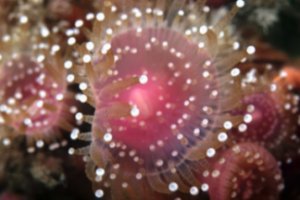 Anemone is a Greek word meaning wind-flower, and these anemones look like
flowers.
Anemone is a Greek word meaning wind-flower, and these anemones look like
flowers. Jewel anemones are closely related to corals than to true sea anemones.
Anemones have soft bodies called polyps. They have no head or other typical body parts and are over 95% water. Polyps are tubes that have the mouth and tentacles on one end and are sealed on the other. The closed end of the tube is a flattened foot also called the pedal disc the foot attaches to hard surfaces
Found in small colonies attached to hard surfaces such as rocks, shells, submerged timbers gullies and crevices around the coast of New Zealand. They are absolutely wonderful to look at with body colours of pale blue white, pale grey-green, yellow, mauve and a light red colour with tentacles tipped with iridescent pinkish purple.
They grow in clusters of up to several hundreds and up to 2cm in height. I have found lots of these in clusters of many colours together covering large rocks on Goat Island a few miles northeast from Leigh.
People may tell you that if anemones tentacles are small and deflated they might be sick or dead. This is not true. When they are doing this they are just resting.
Anemones do not grow in colonies or produce skeletons. Instead, anemones are called solitary polyps because they grow as individual animals. One feature that anemones do have is a single-celled algae that live inside of anemone and coral polyps. Because they do photosynthesis like plants, the algae need sunlight.